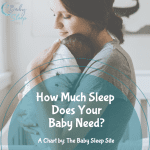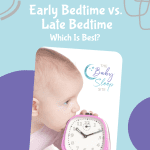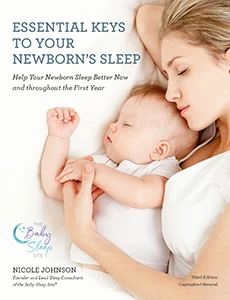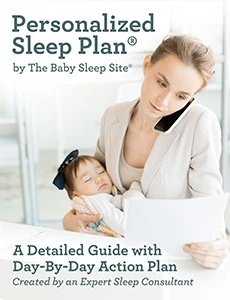
According to different baby sleep books and websites out there, babies drop to one nap anywhere from 10 months to 24 months old. These wide age ranges and contradictions make it hard for parents to figure out what to do. Based on my 15+ years of experience as a baby sleep consultant, the average age to switch to one nap is around 14 months old. This post will help you decide when to switch your baby to one nap.
While newborns will sleep every 1-2 hours all day, most babies will be able to stay awake for 2-3 hours by 4-5 months old. And, most babies will take three naps until 8 months old, on average. That’s one reason the 8 month sleep regression is often more difficult because, on top of the development going on, a nap transition is happening, too.
Once your baby is taking two naps a day, you can usually settle in for a great 2-nap schedule for several months. So, when do babies drop to one nap?
When Do Babies Drop From 2 Naps to One Nap?
Babies usually drop to one nap when they can stay awake comfortably for at least 4-5 hours both before a nap and after a nap which is 15 months old, on average. For most babies, this doesn’t happen until at least 12 months old but sometimes as early as 10 months. In my 15+ years as a sleep consultant, I’ve seen only a handful of 10-month olds truly transition to one nap. Many do it around 13 months old or 14 months old. If your 10 month old is having trouble napping, they are more likely going through the 10 month sleep regression rather than dropping to one nap.
However, because some babies and toddlers are also learning to walk around 12 months old, it’s not always the best time to switch to one nap. Newly walking toddlers can become overly exhausted and start waking at night again. Also, we sometimes see a temporary 12-month sleep regression at 11-12 months old. After this regression is over, babies will still take two naps for a couple more months.
Depending on what book you read, you might read that 12 months is a good time for babies to drop to one nap. Many daycares do it around this age, too. For some babies, this will work out just fine. However, if your baby is sensitive to being overtired and can’t stay awake for long periods of time, this can be a disaster! We have seen it many times over the years, unfortunately.
On the other hand, if your toddler is 18 months old and still taking two naps, you might be having problems with insomnia or early waking. How can you transition your toddler to one nap when they are waking up at 5:00 AM? More on that with the tips below.
Signs to Transition Baby to One Nap
There are a few definitive signs we look for before we switch a baby to one nap including:
- Nighttime sleep decreases below 10 hours.
- Insomnia for 1.5-2+ hours at night several times a week (also called a split night).
- Bedtime past 9 PM (unless your family has an intentionally late schedule.)
- Skipping one of their naps 4 or more times a week.
- Suddenly taking two 45-minute naps
Every situation is different so depending on what specific issues you are having, you may or may not want to drop to one nap but these are good signs it could be time. We do not expect to see ALL of these signs. It is more likely to be just one, maybe two, of them. Some babies will drop their morning nap and some will drop their second nap. In my experience, the most common way is to drop the second nap in the afternoon. Once that afternoon nap gets very late in the day, they often skip it.
How to Switch to One Nap
The big question is how to successfully switch to one nap. First, recognize that all nap transitions can be bumpy. And, nap transitions take 2-3 weeks, on average. If you’re having a hard time, it doesn’t mean it’s not the right thing to do. But, if your baby is still struggling after 2-3 weeks, you might want to make some changes.
5 Tips to Drop Baby to One Nap:
- Start delaying the morning nap by 15-30 minutes a day and then move all meals, the second nap, and bedtime 15-30 minutes later, too. You will do this even if your baby woke up early for the day. If your normal nap time is 9:00 AM, move it to 9:30 AM for the day. You can move the naps every day or every other day.
- Stop moving the morning nap once your toddler is staying awake for approximately 5 hours (and no more).
- Keep your baby in bed for at least two hours to help lengthen the nap. Once you transition to one nap, the nap should be 2-3 hours long.
- If the nap is shorter than two hours, move bedtime earlier but no earlier than 6:00 or 6:30 PM to guard against early waking.
- Offer two naps once or twice a week. Being on a 1-nap schedule for one day or a few days is one thing but every day is another. Many babies will start to get more and more overtired over a period of several days. Catch up for one day and then get back to the new schedule the next day.
Dropping to one nap can be challenging so expect it to be bumpy. Once your baby or toddler has adjusted, they will sleep 11-12 hours at night and 2-3 hours during the day, on average. But, what will their schedule look like after they transition to one nap?
What 1-Nap Schedule Should You Use?
The schedule to use with a baby or toddler taking one nap will depend on your baby’s age and how long they can comfortably stay awake between sleep periods. On average, the nap is approximately 5 hours after they wake up for the day and bedtime is 5 hours after they wake up from their nap. As they approach 18-24 months old, we see the awake period increase.
For a complete list of sample schedules, see our sample toddler schedules by month here!
I hope this post has helped you decide when a baby drops to one nap. Dropping from 2 naps to 1 nap isn’t always easy but your baby will adjust. If you have any questions, we’re here to help!
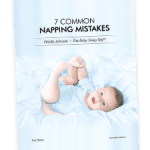 Want FREE sleep help that you can put to use right away? Download a copy of our free guide, 7 Common Napping Mistakes! The guide is available to download instantly, which means you can start using the techniques in it as early as today. So download now, and learn why your baby is not napping – and what you can do about it.
Want FREE sleep help that you can put to use right away? Download a copy of our free guide, 7 Common Napping Mistakes! The guide is available to download instantly, which means you can start using the techniques in it as early as today. So download now, and learn why your baby is not napping – and what you can do about it.
Click here to learn more about how to get your free guide.
A better daytime schedule could be just a few clicks away. So don’t wait – download now, and start your journey to better napping today!



